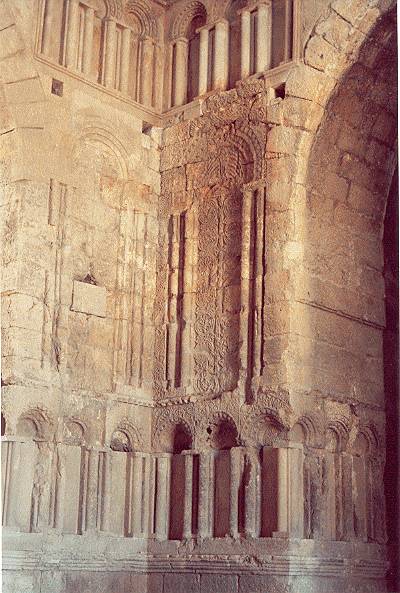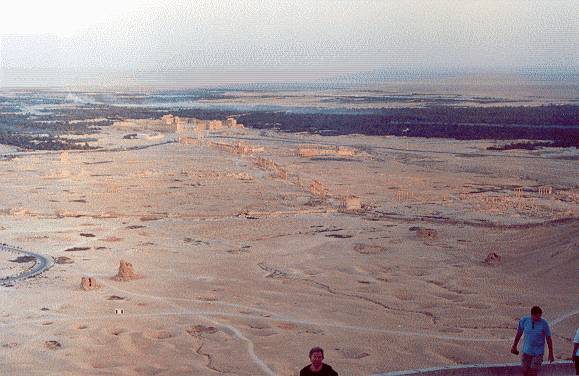
If you are thinking of visiting Syria or Jordan, I was there in 2001 and enjoyed both very much, and this page will give you some clues about it. I have arranged my impressions in a comparison chart:
Syria 
|
Jordan 
|
|
|---|---|---|
| State | Republic; authoritary | Monarchy; democratic (considering...) |
| Ethnic groups | Caucasians of all kinds, mainly semitic | Semitic: Palestinians, Bedouins |
| Languages | Arab, Curd, Armenian, Aramaic | Arab |
| Heritage | Islam (Arab), Bedouin, Ottoman, Byzantine, Roman, Helenistic, Ancient Semitic (Mesopotamic as well as Mediterranean) | Islam (Arab), Bedouin, Roman, Ancient Semitic (Israelite, Nabatean) |
| Unique places | Palmyra, Maalula | Petra |
| National museums | Damascus (vast repertoire, mainly Ancient and Islamic, including the Ugarit alphabet and a complete Palmyra tomb), Aleppo (rich repertoire, mainly Ancient) | Amman (unique collection with some very old pieces, including the Dead Sea writs) |
| Eating | Shares with Lebanon the best gastronomic fame in the (Arab) Middle East. Click here to know what my sample was. | (buy a burger or whatever) |
| Attitude on tourists, safety | Polite but somewhat aloof, it improves a lot after "melting of the ice". No safety problems. | It can be very gentle, especially in Amman (in touristic spots not as much). Safe, I suppose. |
| Ancient History sites | Pre-Roman Palmyra (it is worth crossing the desert to visit this oasis, with its monuments, tombs, and Bedouin food) and others (Ebla, Ugarit, Mari...) | Petra (overwhelming by the originality of the carved façades and the peculiarity of its placement) |
| Roman sites | Apamea and part of Palmyra (both have good things to show). | Jerash (excellent). |
| Christian / Jewish sites | The Christian neighbourhood in Damascus (including the Saint Ananias house where Saul of Tarsus was baptised), the Krak des Chevalliers (a Crusaders fort that should not be missed), Maalula (interesting orthodox community where Aramaic is spoken), Saint Simeon's Basilica (remains of a Byzantine monument). | Mount Nebo (Moses), Bethany (Saint John Baptist), Petra (Moses water source and Aaron's tomb), Madaba (Byzantine church with a famous mosaic map of the Holy Land). |
| Islamic sites | The Damascus Ummayyad Mosque (simply one of the most important Islamic monuments in the world), the wonderful Fatemeh burial mosque in Damascus, the Aleppo citadel (a stronghold in the middle of the city, very well-preserved). | The hill in the Centre of Amman, where the Museum is located, has very interesting remains of an Ummayyad mosque. |
| Landscapes / Leisure tips | Damascus overlooked from the Qassioun mountain. A good lunch in the Al Boustan Restaurant esplanade close to the waterwheels (Norias) on the Orontes in Hama will be unforgettable. | The Al-Mujib canyon, and the desert at Wadi Rum. The gardens close to the Roman Amphiteatre in Amman are a very pleasant place for relaxation in the evening. |
| Warnings | Customs look for an Israel stamp or visa in your passport and will probably deny entry on that ground. Do not engage in political conversations unless you are a professional diplomat. | Customs may not be as heavy, but as the people are the same as the Palestinians on the other side of the Jordan river, feelings are quite emotional about PLO and related subjects. Entry from Syria by car may take a long while because of customs inspections (unless you go with a local guide). |
| To buy / souks | Olive soap in Aleppo (sometimes comes mixed with laurel, but the real thing is from olive only) to be used on your hair and face skin -- you might be surprised, never mind if it looks like laundry soap (well, the price is much better than some Garnier products using the same stuff). The souk in Damascus has wide streets and is very pleasant to roam through, the one in Aleppo is reportedly vast but may look less friendly for the tourist. | Dead Sea merchandise (water minerals and derived products), reportedly very good for healthcare and beautycare. The markets around the Roman amphiteatre in Amman are busy. |



